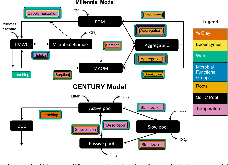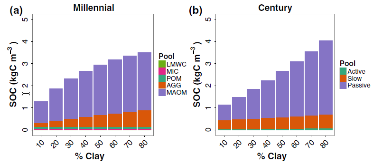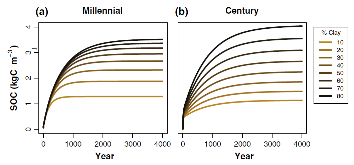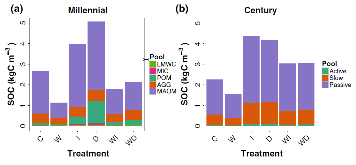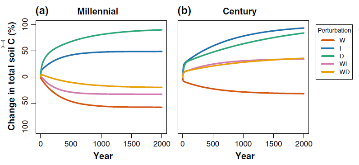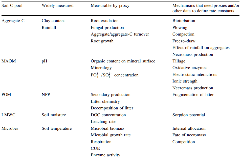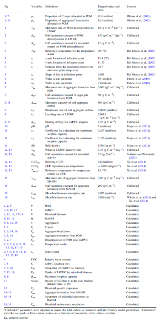|
Representing life in the Earth system with soil microbial functional traits in the MIMICS model
|
journal
|
January 2015 |
|
Effects of soil moisture on the temperature sensitivity of heterotrophic respiration vary seasonally in an old-field climate change experiment
|
journal
|
September 2011 |
|
A theoretical analysis of microbial eco-physiological and diffusion limitations to carbon cycling in drying soils
|
journal
|
June 2014 |
|
Preferential flow descriptions for structured soils
|
journal
|
June 2006 |
|
Understanding the incremental value of novel diagnostic tests for tuberculosis
|
journal
|
December 2015 |
|
Cycling downwards – dissolved organic matter in soils
|
journal
|
September 2012 |
|
Analysis of Factors Controlling Soil Organic Matter Levels in Great Plains Grasslands1
|
journal
|
January 1987 |
|
Aggregate-associated soil organic matter as an ecosystem property and a measurement tool
|
journal
|
January 2014 |
|
Relationships between mineral surfaces and organic carbon concentrations in soils and sediments
|
journal
|
June 1994 |
|
Extracellular enzyme kinetics scale with resource availability
|
journal
|
September 2014 |
|
Evaluating litter decomposition in earth system models with long-term litterbag experiments: an example using the Community Land Model version 4 (CLM4)
|
journal
|
October 2012 |
|
Aggregation and Soil Organic Matter Accumulation in Cultivated and Native Grassland Soils
|
journal
|
January 1998 |
|
Terrestrial ecosystems and the carbon cycle
|
journal
|
February 1995 |
|
Vadose Zone Flow and Transport of Dissolved Organic Carbon at Multiple Scales in Humid Regimes
|
journal
|
January 2006 |
|
Relation between Soil Order and Sorption of Dissolved Organic Carbon in Temperate Subsoils
|
journal
|
January 2012 |
|
Physical and chemical protection in hierarchical soil aggregates regulates soil carbon and nitrogen recovery in restored perennial grasslands
|
journal
|
June 2013 |
|
Contribution of sorption, DOC transport and microbial interactions to the 14C age of a soil organic carbon profile: Insights from a calibrated process model
|
journal
|
September 2015 |
|
Shifts in pore connectivity from precipitation versus groundwater rewetting increases soil carbon loss after drought
|
journal
|
November 2017 |
|
The Dual Arrhenius and Michaelis-Menten kinetics model for decomposition of soil organic matter at hourly to seasonal time scales
|
journal
|
October 2011 |
|
Substrate and environmental controls on microbial assimilation of soil organic carbon: a framework for Earth system models
|
journal
|
February 2014 |
|
Mineral properties, microbes, transport, and plant-input profiles control vertical distribution and age of soil carbon stocks
|
journal
|
April 2017 |
|
Activities of extracellular enzymes in physically isolated fractions of restored grassland soils
|
journal
|
November 2006 |
|
Strategies used by soil biota to overcome soil organic matter stability — why is dead organic matter left over in the soil?
|
journal
|
September 2005 |
|
On the relationships between Michaelis–Menten kinetics, reverse Michaelis–Menten kinetics, Equilibrium Chemistry Approximation kinetics and quadratic kinetics
|
journal
|
January 2015 |
|
Mineral control of soil organic carbon storage and turnover
|
journal
|
September 1997 |
|
The Michaelis-Menten kinetics of soil extracellular enzymes in response to temperature: a cross-latitudinal study
|
journal
|
January 2012 |
|
Carbon Dynamics of Aggregate-Associated Organic Matter Estimated by Carbon-13 Natural Abundance
|
journal
|
January 1996 |
|
Mechanisms of Dissolved Organic Carbon Adsorption on Soil
|
journal
|
January 1989 |
|
Large fluxes and rapid turnover of mineral-associated carbon across topographic gradients in a humid tropical forest: insights from paired 14 C analysis
|
journal
|
January 2015 |
|
Long-term forest soil warming alters microbial communities in temperate forest soils
|
journal
|
February 2015 |
|
Advances in characterization of soil structure
|
journal
|
June 1988 |
|
Old and stable soil organic matter is not necessarily chemically recalcitrant: implications for modeling concepts and temperature sensitivity: SLOW TURNOVER OF LABILE SOIL ORGANIC MATTER
|
journal
|
January 2011 |
|
Contribution of dissolved organic matter to carbon storage in forest mineral soils
|
journal
|
February 2008 |
|
Weaker soil carbon–climate feedbacks resulting from microbial and abiotic interactions
|
journal
|
November 2014 |
|
Microbe-driven turnover offsets mineral-mediated storage of soil carbon under elevated CO2
|
journal
|
November 2014 |
|
Modelling the sensitivity of soil mercury storage to climate-induced changes in soil carbon pools
|
journal
|
January 2013 |
|
A physiological method for the quantitative measurement of microbial biomass in soils
|
journal
|
January 1978 |
|
Development of microbial-enzyme-mediated decomposition model parameters through steady-state and dynamic analyses
|
journal
|
January 2013 |
|
Soil Microbial Community Responses to Multiple Experimental Climate Change Drivers
|
journal
|
December 2009 |
|
Explicitly representing soil microbial processes in Earth system models: Soil microbes in earth system models
|
journal
|
October 2015 |
|
Quantitative and qualitative microscale distribution of bacteria in soil
|
journal
|
October 2001 |
|
Stabilization and destabilization of soil organic matter: mechanisms and controls
|
journal
|
November 1996 |
|
Scaling microbial biomass, metabolism and resource supply
|
journal
|
December 2014 |
|
Development of biogeochemical interfaces in an artificial soil incubation experiment; aggregation and formation of organo-mineral associations
|
journal
|
November 2012 |
|
The Biogeochemistry of Carbon at Hubbard Brook
|
journal
|
August 2005 |
|
Non-cellulosic neutral sugar contribution to mineral associated organic matter in top- and subsoil horizons of two acid forest soils
|
journal
|
February 2010 |
|
AggModel: A soil organic matter model with measurable pools for use in incubation studies
|
journal
|
August 2013 |
|
Sensitivity of decomposition rates of soil organic matter with respect to simultaneous changes in temperature and moisture
|
journal
|
February 2015 |
|
Soil minerals and humic acids alter enzyme stability: implications for ecosystem processes
|
journal
|
October 2006 |
|
Modelling changes in nitrogen cycling to sustain increases in forest productivity under elevated atmospheric CO 2 and contrasting site conditions
|
journal
|
January 2013 |
|
Soil physical properties related to soil structure
|
journal
|
June 1994 |
|
Long residence times of rapidly decomposable soil organic matter: application of a multi-phase, multi-component, and vertically resolved model (BAMS1) to soil carbon dynamics
|
journal
|
January 2014 |
|
Soil Properties Controlling the Adsorption of Dissolved Organic Carbon to Mineral Soils
|
journal
|
January 2009 |
|
Patterns of substrate utilization during long-term incubations at different temperatures
|
journal
|
November 2008 |
|
Decadal cycling within long-lived carbon pools revealed by dual isotopic analysis of mineral-associated soil organic matter
|
journal
|
November 2011 |
|
Sequential density fractionation across soils of contrasting mineralogy: evidence for both microbial- and mineral-controlled soil organic matter stabilization
|
journal
|
August 2009 |
|
Comparison of soil fungal/bacterial ratios in a pH gradient using physiological and PLFA-based techniques
|
journal
|
July 2003 |
|
Protection of organic carbon in soil microaggregates via restructuring of aggregate porosity and filling of pores with accumulating organic matter
|
journal
|
October 2008 |
|
A theoretical model of C- and N-acquiring exoenzyme activities, which balances microbial demands during decomposition
|
journal
|
October 2012 |
|
Soil enzymes in a changing environment: Current knowledge and future directions
|
journal
|
March 2013 |
|
Bacterial and Fungal Contributions to Carbon Sequestration in Agroecosystems
|
journal
|
January 2006 |
|
Quantifying water-stable soil aggregate turnover and its implication for soil organic matter dynamics in a model study
|
journal
|
October 2006 |
|
Soil carbon and nitrogen mineralization: Theory and models across scales
|
journal
|
July 2009 |
|
Clay-sized organo-mineral complexes in a cultivation chronosequence: revisiting the concept of the 'primary organo-mineral complex'
|
journal
|
August 2006 |
|
Seasonality and partitioning of root allocation to rhizosphere soils in a midlatitude forest
|
journal
|
November 2016 |
|
Divergence in plant and microbial allocation strategies explains continental patterns in microbial allocation and biogeochemical fluxes
|
journal
|
July 2014 |
|
Impact of climate change on grassland production and soil carbon worldwide
|
journal
|
February 1995 |
|
Decomposition of added and native organic carbon from physically separated fractions of diverse soils
|
journal
|
November 2013 |
|
Changes to particulate versus mineral-associated soil carbon after 50 years of litter manipulation in forest and prairie experimental ecosystems
|
journal
|
March 2014 |
|
The turnover of organic carbon in subsoils. Part 2. Modelling carbon turnover
|
journal
|
April 2008 |
|
A new model for humic materials and their interactions with hydrophobic organic chemicals in soil-water or sediment-water systems
|
journal
|
February 1986 |
|
Responses of two nonlinear microbial models to warming and increased carbon input
|
journal
|
January 2016 |
|
Microaggregation and organic matter storage at the silt-size scale
|
journal
|
July 2008 |
|
Factors affecting the molecular structure and mean residence time of occluded organics in a lithosequence of soils under ponderosa pine
|
journal
|
October 2014 |
|
Modeling Soil Organic Matter in Organic-Amended and Nitrogen-Fertilized Long-Term Plots
|
journal
|
January 1992 |
|
The Microbial Efficiency-Matrix Stabilization (MEMS) framework integrates plant litter decomposition with soil organic matter stabilization: do labile plant inputs form stable soil organic matter?
|
journal
|
February 2013 |
|
Direct Measurement of Oxygen Profiles and Denitrification Rates in Soil Aggregates1
|
journal
|
January 1985 |
|
Direct evidence for microbial-derived soil organic matter formation and its ecophysiological controls
|
journal
|
November 2016 |
|
Soil organic matter dynamics during 80 years of reforestation of tropical pastures
|
journal
|
June 2009 |
|
Persistence of soil organic matter as an ecosystem property
|
journal
|
October 2011 |
|
Managing uncertainty in soil carbon feedbacks to climate change
|
journal
|
July 2016 |
|
Predicting decadal trends and transient responses of radiocarbon storage and fluxes in a temperate forest soil
|
journal
|
January 2012 |
|
Plant, microbial and ecosystem carbon use efficiencies interact to stabilize microbial growth as a fraction of gross primary production
|
journal
|
February 2017 |
|
Interplay between soil drying and root exudation in rhizosheath development
|
journal
|
October 2013 |
|
Microbial diversity affects self-organization of the soil–microbe system with consequences for function
|
journal
|
October 2011 |
|
Microbial carbon use efficiency: accounting for population, community, and ecosystem-scale controls over the fate of metabolized organic matter
|
journal
|
February 2016 |
|
Changes in soil organic carbon storage predicted by Earth system models during the 21st century
|
journal
|
January 2014 |
|
DAYCENT and its land surface submodel: description and testing
|
journal
|
December 1998 |
|
A framework for representing microbial decomposition in coupled climate models
|
journal
|
August 2011 |
|
Litter and Root Manipulations Provide Insights into Soil Organic Matter Dynamics and Stability
|
journal
|
January 2014 |
|
Intermediate-scale community-level flux of CO2 and CH4 in a Minnesota peatland: putting the SPRUCE project in a global context
|
journal
|
August 2016 |
|
Soil macroaggregate turnover and microaggregate formation: a mechanism for C sequestration under no-tillage agriculture
|
journal
|
December 2000 |
|
Climate, soil texture, and soil types affect the contributions of fine-fraction-stabilized carbon to total soil organic carbon in different land uses across China
|
journal
|
May 2016 |
|
Contributions of interacting biological mechanisms to soil aggregate stabilization in restored prairie1The submitted manuscript has been created by the University of Chicago as operator of Argonne National Laboratory under Contract No. W-31-109-ENG-38 with the U.S. Department of Energy.1
|
journal
|
July 1998 |
|
Fast turnover of low molecular weight components of the dissolved organic carbon pool of temperate grassland field soils
|
journal
|
April 2007 |
|
Global soil carbon projections are improved by modelling microbial processes
|
journal
|
July 2013 |
|
Modeling soil CO2 emissions from ecosystems
|
journal
|
March 2005 |
|
Decomposition of rice straw and microbial carbon use efficiency under different soil temperatures and moistures
|
journal
|
October 2000 |
|
The temperature response of soil microbial efficiency and its feedback to climate
|
journal
|
January 2013 |
|
Evaluating ecosystem responses to rising atmospheric CO2 and global warming in a multi-factor world
|
journal
|
May 2004 |
|
An extraction method for measuring soil microbial biomass C
|
journal
|
January 1987 |
|
SOM fractionation methods: Relevance to functional pools and to stabilization mechanisms
|
journal
|
September 2007 |
|
Selective Sorption of Dissolved Organic Carbon Compounds by Temperate Soils
|
journal
|
November 2012 |
|
Sorption of DOM and DOM fractions to forest soils
|
journal
|
December 1996 |
|
Evaluation of 11 terrestrial carbon-nitrogen cycle models against observations from two temperate Free-Air CO 2 Enrichment studies
|
journal
|
January 2014 |
|
Microbial community-level regulation explains soil carbon responses to long-term litter manipulations
|
journal
|
October 2017 |
|
Elevated atmospheric carbon dioxide concentration: effects of increased carbon input in a Lolium perenne soil on microorganisms and decomposition
|
journal
|
April 2000 |
|
Integrating microbial physiology and physio-chemical principles in soils with the MIcrobial-MIneral Carbon Stabilization (MIMICS) model
|
journal
|
January 2014 |
|
Absolute Quantification of Individual Biomass Concentrations in a Methanogenic Coculture
|
journal
|
April 2014 |
|
Plant versus microbial controls on soil aggregate stability in a seasonally dry ecosystem
|
journal
|
June 2016 |
|
Formation of soil organic matter via biochemical and physical pathways of litter mass loss
|
journal
|
September 2015 |
|
Organic matter and water-stable aggregates in soils
|
journal
|
June 1982 |
|
A parsimonious modular approach to building a mechanistic belowground carbon and nitrogen model: Parsimonious, Modular Model of Belowground C and N Cycling
|
journal
|
September 2017 |
|
The implications of exoenzyme activity on microbial carbon and nitrogen limitation in soil: a theoretical model
|
journal
|
April 2003 |
|
Responses of a tundra system to warming using SCAMPS: a stoichiometrically coupled, acclimating microbe–plant–soil model
|
journal
|
February 2014 |
|
Interactions and Self-Organization in the Soil-Microbe Complex
|
journal
|
June 2004 |
|
The effect of vertically resolved soil biogeochemistry and alternate soil C and N models on C dynamics of CLM4
|
journal
|
January 2013 |
|
Ultraviolet photodegradation facilitates microbial litter decomposition in a Mediterranean climate
|
journal
|
July 2015 |
|
Soil-carbon response to warming dependent on microbial physiology
|
journal
|
April 2010 |
|
Thermal Stability of Goethite-Bound Natural Organic Matter Is Impacted by Carbon Loading
|
journal
|
December 2015 |
|
Soil Water Hysteresis in Water-Stable Microaggregates as Affected by Organic Matter
|
journal
|
January 2008 |
|
A conceptual model of organo-mineral interactions in soils: self-assembly of organic molecular fragments into zonal structures on mineral surfaces
|
journal
|
June 2007 |
|
Soil warming, carbon-nitrogen interactions, and forest carbon budgets
|
journal
|
May 2011 |
|
Stability of organic carbon in deep soil layers controlled by fresh carbon supply
|
journal
|
November 2007 |
|
Ecoenzymatic Stoichiometry and Ecological Theory
|
journal
|
December 2012 |
|
Methodological uncertainty in estimating carbon turnover times of soil fractions
|
journal
|
September 2016 |
|
Acid hydrolysis of easily dispersed and microaggregate-derived silt- and clay-sized fractions to isolate resistant soil organic matter
|
journal
|
August 2006 |
|
The contentious nature of soil organic matter
|
journal
|
November 2015 |
|
Causes of variation in soil carbon simulations from CMIP5 Earth system models and comparison with observations
|
journal
|
January 2013 |
|
Representing life in the Earth system with soil microbial functional traits in the MIMICS model
|
journal
|
January 2015 |
|
Soil physical properties related to soil structure
|
journal
|
December 1994 |
|
Integrating microbial physiology and physiochemical principles in soils with the MIcrobial-MIneral Carbon Stabilization (MIMICS) model
|
journal
|
January 2014 |
|
Large fluxes and rapid turnover of mineral-associated carbon across topographic gradients in a humid tropical forest: insights from paired 14 C analysis
|
journal
|
January 2015 |
|
Persistence of soil organic matter as an ecosystem property
|
text
|
January 2011 |
